
|
 |
WHAT IS NATURAL RESOURCES MANAGEMENT?
Natural resources management is the art and science of maintaining the benefits and values of forest, tundra, and other environments for present and future generations of people. The concept of management originated when people realized that uncontrolled human activities often led to undesirable consequences, such as shortages of wood, disappearance of fish and wildlife, alterations of local climates and water tables, disappearance of clear-flowing streams, flooding, and loss of soil through erosion. People slowly recognized that these consequences could be avoided if use of natural resources such as wildlife, timber, soil, and water was limited and managed.

Initially, management of natural resources focused on using trees and game animals as renewable resources. Trees and wildlife can be harvested then re-grown unlike non-renewable
resources such as coal, oil, and gas. Regulations on wood cutting, logging, hunting, and trapping were the first tools of natural resource managers. Forest managers developed different methods for harvesting trees. They determined how to build logging roads to prevent erosion. They established guidelines and methods for the replanting of trees after logging (reforestation). Wildlife managers set up hunting and trapping seasons and established bag limits to ensure that enough animals survived to reproduce. To encourage people to follow forest and wildlife management regulations, public information campaigns were undertaken to make people more aware of the value of natural resources.
Over time, natural resource managers experimented with changing natural conditions to produce more of a given benefit from natural environments. The techniques used by managers to alter forest ecosystems included various harvesting techniques, the planting of certain species of trees, the application of insecticides and herbicides to reduce insect or selected plant populations, and fertilization of soils with synthetic nutrients. Wildlife managers have used similar techniques to increase wildlife populations.
More recently, natural resource managers have recognized fire as a valuable management tool. In the boreal forest and tundra ecosystems, fire is one of the few tools that managers believe can provide significant benefits.
WHY DO FIRES HAVE A "BAD" REPUTATION?The use of fire for management is limited because few people recognize the beneficial effects of fire. Historically, both Native American people and European settlers used fires for cooking, heating, signaling, hunting, and combating insect pests. These fires sometimes escaped and burned surrounding forests and tundra. In addition, some people purposefully set fires to clear vegetation, drive game animals, or provide a supply of dry wood. Little or no effort was made to prevent or control fires in North America until the early 1900s.

The growth of the logging industry and the beginnings of forest management led to recognition of the commercial value of trees. Fires were seen to destroy wood that might have been cut and sold. Fires caused losses of valuable natural resources, and because they often occurred near human habitation, they often destroyed homes and property. As lands were settled, fires threatened more homes and businesses. Soon, natural resource managers, loggers, and others began to pressure governments to suppress fires to prevent loss of human-made and natural resources.
Smokey Bear and his message "Help Prevent Forest Fires" are known across the nation. His message is directed at human-caused fires. Fire management policy, until recently, has encouraged suppression of all fires.
This policy extended to the boreal forest and tundra of Alaska. Less than one-fifth of the boreal forest contains commercial quantities of wood. Much of this is in remote areas where harvest and transport of the wood to markets is not feasible. Complete fire suppression has never been justified in Alaska either for human safety or protection of valuable resources, but the public and governments nevertheless adopted a policy of putting out all fires.
WHY NOT PUT ALL FIRES OUT?Ironically, as manpower, dollars, and the technology to fight fires increased, the science of ecology began to reveal the natural role of fire in some ecosystems, such as the boreal forest and tundra. Left undisturbed by fire, natural succession in the boreal forest leads to a climax stage forest. Some research suggests that black spruce/feather moss stands are the final stage of succession in the boreal forest, even on well drained soils. This forest type is the least productive of all boreal forest types. Tree growth is minimal, and this forest type supports relatively few kinds of wildlife. Extensive stands of black spruce/feather moss provide little variety in wildlife habitat, little wood, and few berries, mushrooms, or other forest products. See "How do fires in the boreal forest affect wildlife populations?" in Unit II background section.
Understanding the role of fire in the boreal forest ecosystem led to recognition that fire was needed to maintain the vegetative mosaic providing habitat for wildlife and benefits for people. This led to the realization that suppression of all fires was not always necessary and could be harmful in the long term.
Scientists and natural resource managers began to press for changes in public fire policies as they recognized these problems. Today, public views about fires are in transition. It is difficult for many people to understand that some fires are necessary and beneficial after years of hearing that fires are harmful. In addition, established fire fighting programs are slow to change.
WHAT UNEXPECTED EFFECTS HAVE RESULTED FROM FIRE SUPPRESSION?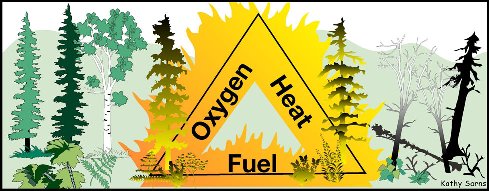
A fire must have three things in order to burn: oxygen, heat, and fuel. Oxygen is not limited in most cases, and lightning is a common heat source. Thus, the amount and condition of available fuel is the most important variable in determining whether or not a fire will burn and how far and fast it will spread. Fuel that feeds a fire includes live and dead trees, shrubs, and the organic mat on the soil surface. In tundra, trees are generally absent, so fire is fueled by grasses, sedges, shrubs, and the organic mat.
Natural resource managers are still trying to gain a better understanding of the complex relationships between fuel accumulation, forest succession, and fire. Some scientists and managers think that fire suppression in the boreal forest may inadvertently increase fire danger. Fires burn in a patchy pattern. They burn intensely in sites with high fuel build-up, but only lightly in places where little fuel has accumulated. Repeated light fires can prevent accumulations of fuel. As a result, the fires that occur have less fuel to feed them and tend to burn smaller areas more lightly.
Unfortunately, fire suppression allows high accumulation of fuels and can sometimes lead to explosive, fast-moving, high intensity fires that consume large areas of forest. Recovery of vegetation and wildlife following a high intensity fire is less predictable and requires more time than following a light fire. Soils are damaged in heavily burned sites, which further slows revegetation.
Scientists have found that some sites supply more fuel for fires than others. For example, mature spruce forest stands, particularly black spruce stands, are more likely to catch fire and tend to burn faster and hotter than young forests dominated by aspen and birch. Similarly, fires are more likely to ignite and burn hotter and faster in forest sites where insect outbreaks or other events have killed trees and created a supply of dry fuel. However, in some instances a young spruce forest with dense stands of trees may burn faster and hotter than an old forest with widely spaced trees. Resource managers need more information on the complex relationships between fire behavior and forest age.
Recognition that fires, fuel build-up, and plant and wildlife succession are interrelated has led resource managers to realize that fire is not only natural, but also a necessary part of the boreal forest ecosystem. Its role in the tundra is less understood, but it is apparent that fires are also a natural part of some tundra environments.
WHAT ARE THE OTHER COSTS OF FIRE SUPPRESSION?In the boreal forest, absence of repeated fires may lead to gradual, but steady, declines in the abundance of some kinds of wildlife, forest wood production, and the scenic beauty of the forest mosaic. The effects of complete fire suppression on tundra productivity are less clear.
In boreal forest areas, complete fire suppression has other potential long-term costs. In the absence of repeated fires, dead trees, branches, and other organic matter can accumulate. This sometimes creates conditions for the kind of explosively hot, fast moving fire that fire fighters cannot stop or control. This type of fire is the most expensive to fight, burns the greatest acreage, and is most likely to cause losses of property and human life. Heavily burned sites also take longer to recover. Thus, complete fire suppression may lead to greater and longer-term economic hardships than a management policy that recognizes the natural role of fire.
Fire suppression has other negative consequences in both the boreal forest and tundra. Fire suppression techniques include the cutting of fire lines and spraying of fire retardants. In some cases, these suppression activities have caused more severe damage than the fire being fought. Construction of a fire line involves removing the vegetation and scraping the soil surface down to the mineral layer. This line helps stop fire from spreading by depriving the advancing fire of fuel. However, on permafrost soils, fire lines reduce the insulation of the soil. This can lead to melting of the permafrost and severe erosion problems. Erosion ditches 16 to 33 feet (5 to 10 m) deep have resulted from fire lines even on relatively gentle permafrost terrain, and in some cases erosion has continued for 10 years or more after the fire. Fire lines constructed using bulldozers, other heavy equipment, and fire line explosives are the most damaging. In tundra areas, the effects of a fire may only be visible for 6 to 8 years, but the effects of fire suppression may be visible for decades or even centuries.
Fire retardants can also damage boreal forest and tundra ecosystems. When these are dumped in or near water, they can kill fish and other aquatic organisms. In places where people rely on fish resources, the damage to fish habitat may be more serious than fire damage. Fire suppression crews can also cause damage. They may be pushed for time and working under less than optimum conditions and sometimes leave behind litter and camps, which reduce the quality of the lands where they worked.
In any case, complete fire suppression is really not possible. Despite a policy of complete fire suppression between 1940 and 1980, over 4000 lightning-caused fires occurred and burned over 18 million acres of Alaska forest and tundra. Fire management is the only rational and feasible course of action.
HOW CAN FIRE BE USED AS A MANAGEMENT TOOL?Rather than viewing fire as the enemy, land and resource managers today see fire as a useful and effective tool for habitat enhancement and increasing the yield of valuable forest and tundra products (such as wood, berries, mushrooms, wildlife, furs, and meat) and benefits.
Using fire to increase the yield of wood from the boreal forest may seem illogical, but fire can do this in some places by enriching the soil with nutrients, raising soil temperatures, and by clearing out dense stands of old, slow growing trees. By managing the timing of fires, forest managers may be able to affect the kinds of trees growing on a given site and increase their rate of growth. Fires also dry out standing wood and can create a temporary, valuable source of dry firewood in accessible areas.

Fires can be used to increase yields of blueberries, raspberries, and other species. These berry plants often flourish in burned areas due to increased nutrients, reduced competition, and shading by other plants. Increased berry production has been observed following fire in both forest and tundra areas. In the lower 48 states, fire is a common management tool used to increase blueberry production.
Fire can also be used to manage wildlife populations, particularly in the boreal forest. The abundance of wildlife in an area will likely drop immediately following fire. However, the numbers of some species generally recover in a few years. Many species return in greater numbers than existed before the fire. Yields of furs and meat can be increased by fire, since a variety of furbearers and game animals, such as marten, foxes, and moose, find ideal feeding habitat in the early stages of forest succession. Waterfowl and aquatic furbearer populations can also benefit from fire because fires increase nutrients and can help form wetlands and ponds in both forest and tundra areas (see Effects of Fire on Wildlife Populations Handout in Unit 2).
Fire can also be used in some circumstances to reduce insect damage to trees. By burning dead and down trees in regions where bark beetle outbreaks are occurring, fires can help reduce insect habitat. This could potentially reduce insect attacks on otherwise healthy trees. This insect control method has been suggested as an alternative to the use of pesticides.
WHO IS IN CHARGE OF MANAGING FIRES?Recognition of fire as a management tool in Alaska has grown over the past 20-35 years. Meetings between agencies, natural resource managers, scientists, and the public gradually led to the adoption of an updated fire management policy and plans.
The Alaska Wildland Fire Coordinating Group (AWFCG) oversees the coordination and direction of the interagency wildland fire management efforts in Alaska. The AWFCG has completed the long-term project to amend the 13 Area Specific Alaska Interagency Wildfire Management Plans into one plan. This effort was undertaken to eliminate the need to refer to three documents to fully understand wildland fire operations in Alaska, to incorporate operational changes, to clarify the language of the plan and to update terminology. The organization of the original area-specific plans required most local land managers/owners to use their local interagency fire management plan and refer to the Alaska Interagency Fire Management Plan, Tanana/Minchumina Plan and the 1984 amendment to the interagency plans. The 1998 amendment entitled, "Alaska Interagency Wildland Fire Management Plan" provides the land owners/managers one document to guide their management options, responsibilities, and operation of wildland fire management in Alaska. This makes it much easier for Alaska fire suppression organizations to deploy their limited resources in the heat of battling wildfires.
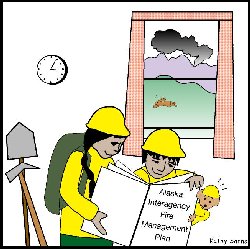
The 1998 amendment contains the common elements of the area-specific plans. It does not change the intent of the area-specific plan nor does not it change any landowners'/managers' fire management option selections or any fire protection option boundaries. The landowners'/managers' responsibilities and ability to determine how fire will be managed on their lands has not changed. Other than having one document to use, there should be no noticeable change to the land owners/managers. The Coordinating Group is made up of representatives from federal agencies, the State of Alaska, Alaska Native organizations, and local governments. The Alaska State agencies involved include the Department of Fish and Game (ADFG), the Department of Natural Resources (ADNR), and the Department of Environmental Conservation (ADEC). The federal agencies involved include the US Fish and Wildlife Service (USFWS), Bureau of Land Management (USBLM), the National Park Service (USNPS), and the Forest Service (USFS), the Bureau of Indian Affairs (USBIA). Specific native organizations as of 1999 are Chitin Village Traditional Council, Chugachmiut Inc., and the Tanana Chiefs Conference.
WILDLAND FIRE MANAGEMENT OPTIONSLands are divided into four fire protection categories called Management Options based on the resource values to be protected, as determined by the respective landowners and managers. When fires do occur, the Alaska Fire Service (sponsored by USBLM), ADNR Division of Forestry, and USFS are jointly responsible for providing suppression services.
1. Critical Management Option - This category is assigned to lands where human lives and property require that immediate, top priority fire protection be provided. Fires on these lands will be given unquestioned priority in the allocation of fire fighting funds, manpower, and equipment. Fires will be immediately and aggressively suppressed. 2. Full Management Option - Areas in this category include lands with high cultural or historical values or other resource values that landowners or managers determine to need fire protection. These lands are generally uninhabited. On lands classified for full protection, all fires will be aggressively fought throughout the fire season. 3. Modified Management Option - This category can serve as a buffer area between Full Protection and Limited Action areas. It includes lands where fire protection is needed during critical burning periods (unusually dry months), but where fires are otherwise desirable. On these sites, immediate fire fighting action is taken if conditions indicate that a large fire could occur (generally during the first and drier part of each fire season). If the fire cannot be contained the first day, an escaped fire situation analysis (EFSA) will be made to determine levels of continued action. When the danger is deemed low due to wetter conditions, no initial attack is made on new fire starts, and these lands are treated much like those in Limited Action areas. This generally occurs later in the fire season, historically after July. 4. Limited Management Option - This category recognizes those areas where a near natural fire regime is desirable, or where the resource values at risk are worth less than it would cost to launch a fire fighting effort. On these lands, fires are only monitored unless they threaten lands in other higher-valued categories or critical sites within the area. Suppression action then will be taken if the responsible land management agency deems it necessary. WHO USES THESE MANAGEMENT OPTIONS?The Alaska Fire Service, the US Forest Service, and the State of Alaska use these land categories as fire suppression guidelines. These agencies use the land categories to determine the appropriate kind of suppression response required when a fire is detected. Because land-ownership, settlement, and resource values may change, the fire protection categories contained in the plan are reviewed on an annual basis.
WHY IS THE ALASKA INTERAGENCY WILDLAND FIRE MANAGEMENT PLAN IMPORTANT?The plan provides a method for fire-fighting agencies to allocate limited manpower and money. This allows them to place the manpower and money where it is needed most to fight fires that threaten human life and property and, secondarily, cultural, historical, and other valuable resources. The ability to wisely allocate fire-fighting efforts is likely to become more important in the future since both federal and state moneys to fight fires are likely to decline. Federal revenues may decline due to the national deficit and competition with other federal programs for scarce funds. State revenues are expected to decline along with oil revenues. Thus, Alaskans must have a means of wisely allocating funds to ensure adequate fire protection where it is most needed.
The fire management plans also allow the possibility of returning fire to its near natural and valuable role in parts of the boreal forest and tundra. All federal agencies will identify important resources that must be protected, and fight fire in those areas. The fires on lands with no identified important resources will normally not have natural fires suppressed. This is necessary to ensure that these ecosystems continue to provide the many products and benefits that they provide today. Along with the desire to reduce fire suppression costs, this may be a primary goal of land and resource managers.
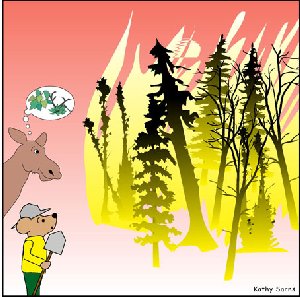 FIRE MANAGEMENT AND PEOPLE
FIRE MANAGEMENT AND PEOPLE
Recognition of the important natural role of fire and its potential as a management tool has led to changes in fire management policies. But fire management remains a complicated issue. In the absence of people, naturally occurring fires would maintain the boreal forest and tundra mosaics without need for management. But people live, work, and recreate in these environments. Fire management policies must take into account not only the ecological effects of fire, but also the effects on the people who use these environments.
For people who learned that all fires are harmful and have become accustomed to a policy of putting out all fires, the new fire management policy may seem confusing. And, despite the great change in public policy toward fires, the media continues to report both the number of acres 'lost to" or "destroyed by" fire each year and the millions of dollars spent to "fight" fires. These reports help maintain a public misconception that fires are destructive, harmful, and costly--in other words, bad. This simplistic view of fire and its effects must be replaced by a fair assessment of the costs and benefits of both the natural role of fire and fire suppression over the short and long term.
WON’T LIVES AND PROPERTY BE THREATENED IF FIRES ARE NOT SUPPRESSED?The most important potential cost of fire is the threat posed to human lives and property. As illustrated by the Alaska Interagency Fire Management Plans, everyone agrees that all fires in areas where human lives and property are threatened must be given immediate priority and full attention when allocating fire-fighting resources. The Alaska Interagency Fire Management Plans actually increase the amount of protection and fire suppression in populated areas because human and equipment resources that might once have been used in remote Limited Management Options now can be dedicated to Critical and Full Management Options.
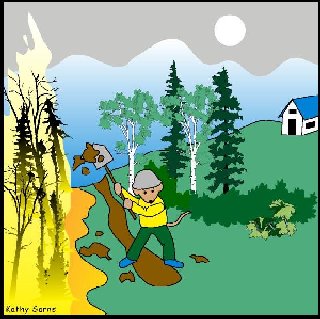
The Alaska Interagency Fire Management Plan ensures that Critical Management Options, where human lives and property are threatened, receive complete, top priority attention in the allocation of fire-fighting funds and manpower.
WON'T ALLOWING SOME FIRES TO BURN CREATE MORE SMOKE?The tremendous amount of smoke generated by wildland fires is undesirable, but unavoidable. Often clouds of smoke, even from distant fires, drift or are blown into towns and villages. This smoke can greatly reduce visibility, which detracts from the scenic qualities of Alaska. Occasionally, thick smoke can interrupt small plane service to remote villages and towns. Thick smoke can also interfere with fire detection and suppression activities. Residents and visitors dislike breathing smoke and the eye irritation smoke sometimes causes. Thick smoke can cause temporary breathing problems for the very young and old. This occasionally requires that these people be evacuated from the area. For all these reasons, people often express concern about the smoke generated by fires.
Concerns regarding fire smoke are valid, but the problem is more of a temporary irritation to people than a threat. Wildland fire smoke consists mainly of carbon dioxide and water vapor. These are not considered pollutants since both are natural components of the air. The ash in smoke causes the most serious problems. Ash laden smoke irritates eyes, causes breathing difficulties for some people with existing health problems, and reduces visibility. In general, however, smoke does not pose a serious danger to health.
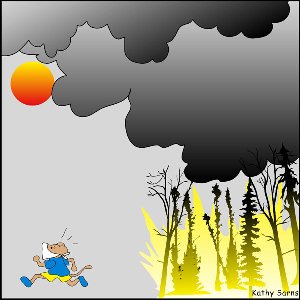
Other chemicals in smoke include carbon monoxide, nitrous oxide, a variety of hydrocarbons, and ash (or particulates). High concentrations of carbon monoxide, a dangerous and potentially lethal gas, have been found in the active part of some fires. Concentrations of this gas decrease rapidly in all directions from the fire, however, so it only threatens people and wildlife in the immediate area of the fire. Nitrous oxide, a component of photochemical smog which results in damaging compounds such as ozone, can be caused by fire as it is formed when air temperatures exceed 2800 r (1538oc). The amount of nitrous oxide formed by wildland fire does not appear significant.
Hydrocarbons result from the burning of the volatile oils, waxes, and resins in forest and tundra plants. The amount of hydrocarbons released by fires does not appear to be an important factor affecting air quality.
Smoke reduction cannot necessarily be achieved by attempting to put all fires out. In some cases, attempts at fire suppression may change a hotly burning fire that produces little smoke into a cool smoldering fire that produces great clouds of thick smoke. Suppression of small fires during low fire years may inadvertently create conditions for a disaster fire that produces more severe smoke problems another year. Fires in Alaska's boreal forest can only be postponed; they can never be entirely prevented or suppressed.
HOW DO FIRE MANAGEMENT PLANS AFFECT FIRE FIGHTING COSTS?Fire suppression costs Alaska and the federal government millions of dollars each year; fire suppression is an expense to everyone. In 1988, which was a particularly heavy fire year, the cost of fighting fires in Alaska was over $29 million dollars. When many fires are burning, not enough manpower, equipment, or money exists to fight all fires. The Alaska Interagency Fire Management Plan addresses this problem by providing a reasonable method for allocating limited suppression funds and manpower. Clearly, when money and manpower are in short supply, control efforts should focus on fires that threaten lives, homes, or valuable resources rather than on fires burning in wild areas where no people live and where existing forest resources cannot be harvested or are rarely used.
In the long term, the Alaska Interagency Fire Management Plan should reduce fire-fighting costs. By allowing wildland fires to burn in Limited Management Options and reduce fuel loads in those areas, it also reduces the danger of large fires in the future. Unfortunately, since fire suppression has been practiced in the past 40 years, high fuel loads currently exist in some areas. Fires in Limited Management Options can, and have sometimes, moved into areas where fire suppression is required. Since it is less expensive to attempt suppression or control of a small fire, the limited action response can, in some circumstances, lead to higher fire fighting costs in the short term.
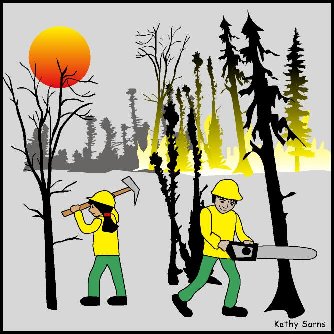 WHAT ABOUT FIREFIGHTER JOBS?
WHAT ABOUT FIREFIGHTER JOBS?
The money expended by governments to fight fires is paid to individual firefighters and to support services providing aircraft, equipment, housing, and food to firefighters. In heavy fire years, many fire fighting crews are employed. This brings a substantial cash flow into some communities. It is particularly important in some remote towns. Under the Alaska Interagency Fire Management Plan, fire fighting jobs and income will continue to flow into Alaska's towns and villages because many fires will still need to be fought. The Alaska Interagency Fire Management Plan has been in place since 1984, yet millions of dollars are still spent every year for fire suppression.
In addition, the Alaska Interagency Fire Management Plan calls for increased use of pre-fire suppression which provides work for firefighters, even in low fire years. Pre-fire suppression techniques include the construction of fire breaks around critical zones or the use of prescribed fires (fires planned, ignited, and controlled by land managers) to reduce heavy fuel loads in selected areas. Construction and maintenance of fuel breaks and prescribed fires will be conducted in years when fire danger is low. Typically, fire fighting income is highly variable and unpredictable because the number and size of fires varies widely from year to year.
Fire fighting jobs are not threatened by the Alaska Interagency Fire Management Plan. In contrast, pre-fire suppression activities, which are necessary for effective fire management, will need to be conducted regularly. In the long run, the Alaska interagency Fire Management Plans should help provide firefighters a more reliable source of revenue.
WHAT ABOUT THE RESOURCES IMPACTED BY FIRES?Fires do not destroy the boreal forest or tundra ecosystems, they only change the successional pattern. Some of the changes are negative, but many are beneficial to wildlife and people. Immediately after a fire, the blackened land provides little in the way of berries, game animals, or furbearers. It also offers few scenic values or recreational opportunities. These changes can cause severe, though temporary, hardships to the people who depend on the natural resources for their livelihoods. Hunters, trappers, and tourist guides may be affected.
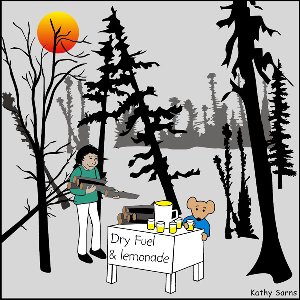
But the negative economic effects of fire are counter-balanced by many beneficial effects. Even in the short-term, forest fires can benefit communities by leaving scorched trees. These provide needed dry fuel, seasoned logs for building, and jobs for woodcutters. Recovery of vegetation in a burn site may take 1 to 10 years depending on the impact and location of the fire. Once a site recovers through natural plant succession, berry-producing plants and populations of moose, hares, and furbearers are likely to be far greater than before the burn; fires often create better berry-picking, hunting, and trapping opportunities for residents and tourists. Fires are necessary to ensure the continued productivity of the boreal forest and some tundra areas. Even though fires may cause temporary economic hardship for some people and communities, the long-term effects of fire must be considered beneficial.
WHAT SHOULD WE DO?If we wish to maintain the benefits and products of the boreal forest and tundra, we must recognize that fire is a natural and necessary part of these ecosystems. To fairly evaluate the costs and benefits of fire, we must take into account both the short-term and long-term effects of fire and fire suppression. We must be sensitive to the needs of individuals and communities, now and in the future. The Alaska Interagency Fire Management Plan is a tool that helps land and resource managers make the difficult, but necessary decisions about when and where to allow or suppress fires. Public understanding and support of fire management are needed if fire is to be restored to its natural role in Alaska's boreal forest and tundra ecosystems.
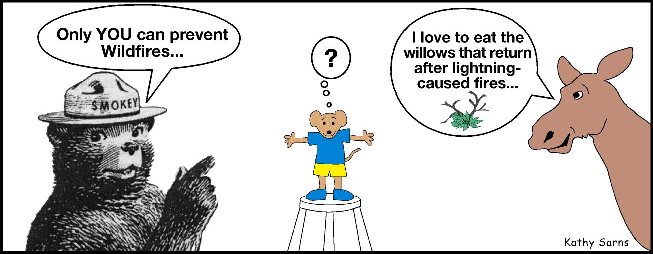
| Printable version | Add to favorites | Make Alaska FWS my homepage |
| Site designed and maintained jointly by the USFWS Alaska Region Division of Information Resource Management (IRM) and External Affairs (EA). |